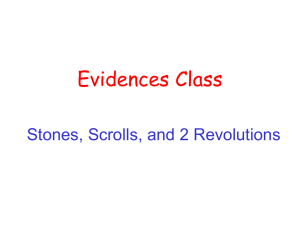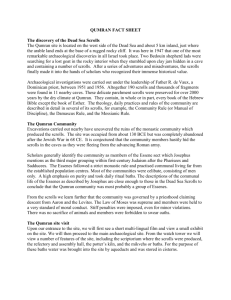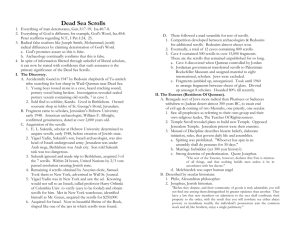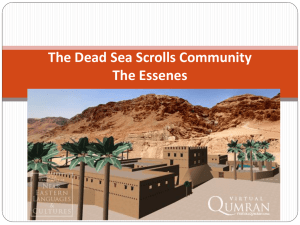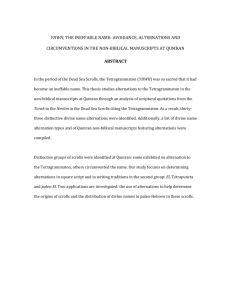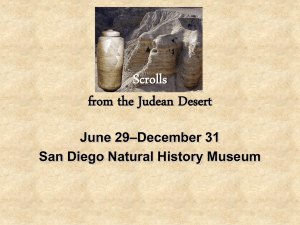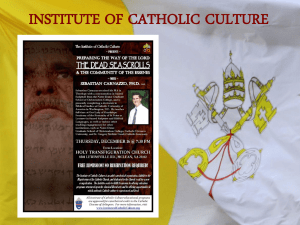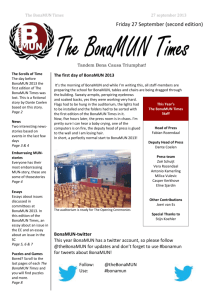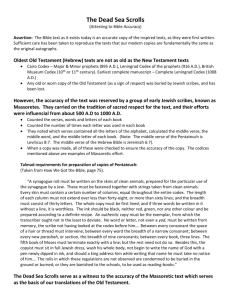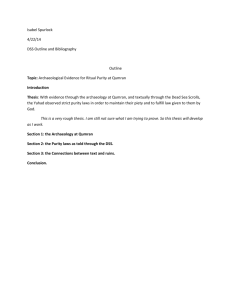Archaeological Spotlight: The Dead Sea Scrolls
advertisement
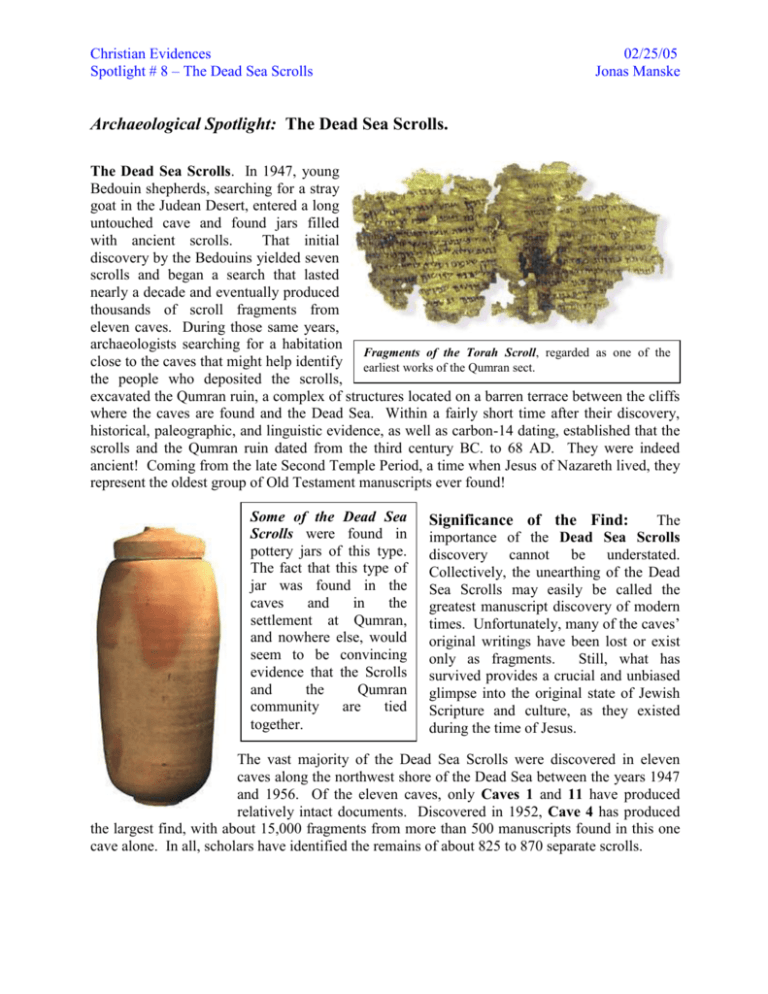
Christian Evidences Spotlight # 8 – The Dead Sea Scrolls 02/25/05 Jonas Manske Archaeological Spotlight: The Dead Sea Scrolls. The Dead Sea Scrolls. In 1947, young Bedouin shepherds, searching for a stray goat in the Judean Desert, entered a long untouched cave and found jars filled with ancient scrolls. That initial discovery by the Bedouins yielded seven scrolls and began a search that lasted nearly a decade and eventually produced thousands of scroll fragments from eleven caves. During those same years, archaeologists searching for a habitation Fragments of the Torah Scroll, regarded as one of the close to the caves that might help identify earliest works of the Qumran sect. the people who deposited the scrolls, excavated the Qumran ruin, a complex of structures located on a barren terrace between the cliffs where the caves are found and the Dead Sea. Within a fairly short time after their discovery, historical, paleographic, and linguistic evidence, as well as carbon-14 dating, established that the scrolls and the Qumran ruin dated from the third century BC. to 68 AD. They were indeed ancient! Coming from the late Second Temple Period, a time when Jesus of Nazareth lived, they represent the oldest group of Old Testament manuscripts ever found! Some of the Dead Sea Scrolls were found in pottery jars of this type. The fact that this type of jar was found in the caves and in the settlement at Qumran, and nowhere else, would seem to be convincing evidence that the Scrolls and the Qumran community are tied together. Significance of the Find: The importance of the Dead Sea Scrolls discovery cannot be understated. Collectively, the unearthing of the Dead Sea Scrolls may easily be called the greatest manuscript discovery of modern times. Unfortunately, many of the caves’ original writings have been lost or exist only as fragments. Still, what has survived provides a crucial and unbiased glimpse into the original state of Jewish Scripture and culture, as they existed during the time of Jesus. The vast majority of the Dead Sea Scrolls were discovered in eleven caves along the northwest shore of the Dead Sea between the years 1947 and 1956. Of the eleven caves, only Caves 1 and 11 have produced relatively intact documents. Discovered in 1952, Cave 4 has produced the largest find, with about 15,000 fragments from more than 500 manuscripts found in this one cave alone. In all, scholars have identified the remains of about 825 to 870 separate scrolls. Christian Evidences Spotlight # 8 – The Dead Sea Scrolls 02/25/05 Jonas Manske The scrolls are most commonly made of animal skins, but also papyrus and one of copper. They are written with a carbon-based ink, from right to left, using no punctuation except for an occasional paragraph indentation. In fact, in some cases, there are not even spaces between the words. For the most part, the scrolls are written in Hebrew, but many were written in Aramaic. Aramaic was the common language of the Jews in Palestine for the two centuries immediately preceding and following Christ, and the discovery of these scrolls has greatly enhanced our knowledge of these two languages. A few texts have also been found that have were written in Greek. A remarkable archaeological find, the Dead Sea scrolls include the Book of Isaiah in its entirety, as well as fragments from all other books of the Hebrew canon except for the Book of Esther. The collective documents averaged roughly 1,000 years older than any other previously known Hebrew texts. The scrolls can be divided into two categories: Biblical and non-Biblical. Significantly, fragments from every book of the Old Testament (Hebrew Canon) have been uncovered except for the Book of Esther. Among the scrolls, portions of 19 copies of the Book of Isaiah have now been identified, 25 copies of the Book of Deuteronomy have been uncovered, and portions from at least 30 copies of the Psalms have been distinctly recognized. The Isaiah scroll, found largely intact, is 1,000 years older than any previously known copy of Isaiah. Prophecies by Ezekiel, Jeremiah and Daniel not found in the Bible have been found written in the Scrolls, which also contain never before seen psalms attributed to King David and to Joshua. The previously unknown last words of Joseph, Judah, Levi, Naphtali, and Amram (the father of Moses) have also been found written in the scrolls. Additionally, the scrolls contain previously unknown stories about biblical figures such as Enoch, Abraham, and Noah. The story of Abraham includes an explanation as to why God asked Abraham to sacrifice his only son Isaac. One of the most curious scrolls is the Copper Scroll. Discovered in Cave 3, this scroll records a list of 64 underground hiding places throughout the land of Israel. The deposits are to contain certain amounts of gold, silver, aromatics, and manuscripts. These are believed to be treasures from the Temple at Jerusalem that were hidden away for safekeeping. Since the late fifties, about 40% of the Scrolls, mostly fragments from Cave 4, remained unpublished and were inaccessible. It wasn't until 1991, 44 years after the discovery of the first Scroll, after the pressure for publication mounted, that general access was made available to photographs of the Scrolls. In November of 1991 the photos were published by the Biblical Archaeological Society in a nonofficial edition; a computer reconstruction, based on a concordance, was announced; the Huntington Library pledged to open their microfilm files of all the scroll photographs. Christian Evidences Spotlight # 8 – The Dead Sea Scrolls 02/25/05 Jonas Manske Numerous non-Biblical writings have also been uncovered among the scrolls, including commentaries on the Old Testament, paraphrases that expand upon the Law, rule books on holy living for the community, hymnic compositions, benedictions and wisdom writings that taken together comprise a significant amount of the recovered writings. Ruins of the Qumran community in Jordan, site of the important Dead Sea Scrolls discoveries. Collectively, the Dead Sea Scrolls enhance our knowledge of both Judaism and Christianity. They represent a non-rabbinic form of Judaism and provide a wealth of comparative material for New Testament scholars, including many important parallels to early Christianity. They show Christianity to be rooted in Judaism and better help us to understand the historical connections between the two faiths. The Isaiah Scroll. This scroll, which was found in Cave 1, represents perhaps the most important of the discoveries: dating to about 125 BC, the scroll predates the previously oldest complete version of the Hebrew Testament (the Masoretic text) by 1,000 years and represents one of the oldest parts of the Hebrew Testament ever found. Measuring in size 1 foot by 24 feet, the Hebrew text is in 54 columns; the text demonstrates a remarkable similarity with the Masoretic text written a thousand years later. This demonstrates that a 1,000 years of copying had not in any way significantly altered the meaning of the text. “Of the 166 words in Isaiah 53, there are only seventeen letters in question. Ten of these letters are simply a matter of spelling, which does not affect the sense. Four more letters are minor stylistic changes, such as conjunctions. The remaining three letters comprise the word ‘light’, which is added in verse 11, and does not affect the meaning greatly. Furthermore, this word is supported by the LXX [Septuagint] and IQ Is. Thus, in one chapter of 166 words, there is only one word (three letters) in question after a thousand years of transmission – and this word does not significantly change the meaning of the passage.” (Evidence That Demands a Verdict, Josh McDowell, p. 58). A portion of the Isaiah Scroll, found in Cave 1 and predating the time of Christ. It largely confirms that the original Isaiah text, including the incredibly specific prophecies about a “suffering” Savior found in Isaiah 53, had remained essentially unaltered throughout 1750 years of faithful copying. Christian Evidences Spotlight # 8 – The Dead Sea Scrolls 02/25/05 Jonas Manske The Isaiah Scroll is especially important because Isaiah’s prophecies regarding the future Messiah (especially in Isaiah 53) were particularly specific in the information they provided and overwhelming exact: so much so that it would all but impossible to apply them to anyone other than to one man in all of human history, Jesus Christ. The discovery of the Isaiah Scroll in Cave 1 means that it is all but impossible for critics to claim that these prophecies were engineered or created by Christians “after-the-fact” or at a later date than when the prophecies were originally written down. Indeed, the information given simply in Isaiah 53 is so specific in regards to the nature of Jesus’ trial, crucifixion and subsequent resurrection that it reads almost like a “fifth gospel” account, along with Matthew, Mark, Luke and John. Keep in mind that the prophecies in Isaiah were originally written down some 750 years before the life of Christ! According to these predictions, the Messiah will, among other things: 1. 2. 3. 4. 5. be despised and rejected by men. (verse 3). be pierced for man's sin. (verse 5). be silent before his accusers. (verse 7). be cut off: have no descendents. (verse 8). be buried with the wicked but assigned a grave with the rich. (verse 9). 6. see his offspring (verse 10, even despite verse 8), 7. and, prolong his days. (verse 10). A second point of interest is that, in some places where there is a difference from the 10th century AD Masoretic Text, the Dead Sea version agrees with the Septuagint, the Greek translation of the Hebrew A close up picture of cave #5, where many Testament favored by the early Christians. This of the scrolls were found, near the Qumran suggests that the Septuagint may be of equal validity to community. the Masoretic Text as a foundation for our modern Old Testament. (For more information on Isaiah’s Prophecies, see my related study, Christian Evidences Part V – Messianic Prophecies). The Thanksgiving Psalms. The “Thanksgiving Psalms” came in 4 pieces, which, when assembled, comprised 12 columns, each about 13 inches high. The document is comprised of about thirty heretofore-unknown Psalms. (For translations of some of the more complete of these psalms, please click on one of the following links: http://www.piney.com/psalm.html and http://www.webcom.com/~gnosis/library/psalm.htm). Christian Evidences Spotlight # 8 – The Dead Sea Scrolls 02/25/05 Jonas Manske Some scholars have suggested that the Psalms were written by the enigmatic teacher of righteousness, mentioned in the Habakkuk Commentary and the Damascus Document. And indeed, there are places in the text where it appears that the author is someone of special significance: “Thou didst make me a banner for the righteous elect, an interpreter of knowledge in wondrous mysteries.” (Burrows, p. 401). \ The Thanksgiving Psalms have a seeming apocalyptic flavor to them, especially describing the contrast between the “righteous elect,” the “army of the holy ones,” and the “congregation of the sons of heaven” against the “congregation of Belial” and the “interpreters of lies.” In several instances, there is language reminiscent of Revelation, such as: One of the more fascinating discoveries among the Dead Sea Scrolls documents, the Thanksgiving Psalms comprise a collection of approximately thirty previously unknown works similar to the Biblical Psalms. Dating from approximately 75 BC, the Thanksgiving Psalms are an eloquent testimony to the intense spirituality of the Qumran community. “…for in the waves of death she gives birth to a manchild; with pains of Sheol he bursts forth from the crucible of the pregnant one, a wonderful counselor with his power; yes, a man comes forth from the waves…” “The foundations of the mountains are given to the flames; the roots of flint become torrents of pitch. It devours to the great abyss; the torrents of Belial burst into Abaddon; the sentient beings of the abyss roar with the noise of the eruptions of mire.” The Book of Enoch. One of the most important apocryphal works of the Second Temple Period is Enoch. According to the biblical narrative (Genesis 5:21-24), Enoch lived only 365 years (far less than the other patriarchs in the period before the Flood). Enoch “walked with God; then he was no more for God took him.” The original language of most of this work was, in all likelihood, Aramaic (an early Semitic language). Although the original version was lost in antiquity, portions of a Greek translation were discovered in Egypt and quotations were known from the Church Fathers. The discovery of the texts from Qumran Cave 4 has finally provided parts of the Aramaic original. Aramaic fragments of the Book of Enoch, from 250-150 BC, found in Cave 4 of the Qumran community. Christian Evidences Spotlight # 8 – The Dead Sea Scrolls 02/25/05 Jonas Manske The Book of Enoch is a pseudoepigraphal work (a work that claims to be by a biblical character). It was not included in either the Hebrew or most Christian biblical canons, but may have been regarded as a sacred text by the Ante-Nicene fathers. The original Aramaic version was lost in entirety until the Dead Sea fragments were discovered. The Damascus Document. The so-called “Damascus Document” was found by a Jewish scholar, Solomon Shechter in a storeroom for discarded manuscripts in the Ezra Synagogue in Cairo in 1896. It thus represents the first of the Dead Sea Scrolls to be discovered, being well-known among scholars even before the discovery of additional scrolls by the Bedouins in 1948 in the caves near the Qumran community. Its presence has been a source of controversy among the Jewish and Christian communities, because it seemingly predicts the arrival of several enigmatic and important characters, who have yet to be positively identified, including the Teacher of Righteousness or the Righteous Teacher; the Wicked Priest; the Liar or Spouter of Lying who was also called the Scoffer or Comedian, the Traitors, the Violent Ones or the Violent Ones of the Gentiles, the Simple Ones of Judah doing Torah, the Seekers after Smooth Things, the Simple of Ephraim and the Kittim. The Damascus Document was the first of the Scrolls to be discovered in modern times, and its cryptic references to the “Teacher of Righteousness” and other individuals remain a source of controversy for scholars even today. The document begins with an important reference to Nebuchadnezzar of Babylon, and would seem to fix the time of the time period of the “Teacher of Righteousness” around 197-177 BC, during the time period of the Hasmoneans (the Maccabees). “And in the age of wrath, three hundred and ninety years after He had given them into the hand of the King Nebuchadnezzar of Babylon, He visited them, and he caused a plant root to spring from Israel and Aaron to inherit His land and to prosper on the good things of His earth. And they perceived their iniquity and recognized that they were guilty men, yet for many years they were like blind men groping for the way.” “And God observed their deeds, that they sought Him with a whole heart, and He raised them a Teacher of Righteousness to guide them in the way of His heart.” (Opening portion of the Damascus Document). Significant debate has raged as to which historical figures may be among those identified by the document. According to Professor James C. Vanderkam, a leading expert on the scrolls and one of the international team presently translating the scrolls, it is perhaps most likely that the Wicked Priest was either Jonathan the Maccabee or his brother Simon, although he gives no identification for the Teacher. Christian Evidences Spotlight # 8 – The Dead Sea Scrolls 02/25/05 Jonas Manske Others have dated the identification of those pictured in the scrolls to the post-Christian era, more specifically to the time period of the Judean revolt between 66 – 74 AD. More recently, some have identified the Teacher of Righteousness with James, the brother of Jesus, although these efforts seem lacking because they fail to explain why Jesus himself would not be mentioned within the documents. Despite these controversies, the Damascus Document is still important because it reveals that significant amount of Jewish thought was still centered on the idea of a coming Messiah, even during the so-called “Silent Years” between the Old and New Testaments. It is possible that a lack of historical information during this time period has made the proper identification of these individuals more difficult. It is perhaps more likely that the concepts represented within the Damascus Document represent a divergent religious philosophy among the Jews, one that ultimately does not represent genuine prophecy. Coming Next Issue: The Ebla Tablets
